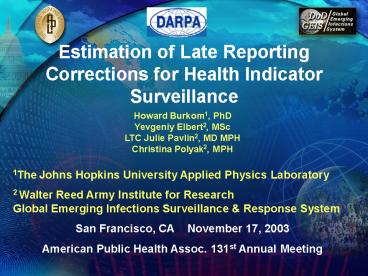Progress Toward Earlier Detection: Alerting Algorithms - PowerPoint PPT Presentation
Title:
Progress Toward Earlier Detection: Alerting Algorithms
Description:
2 Walter Reed Army Institute for Research Global Emerging Infections ... Depends on existence, duration of typical prodrome for underlying disease ... – PowerPoint PPT presentation
Number of Views:39
Avg rating:3.0/5.0
Title: Progress Toward Earlier Detection: Alerting Algorithms
1
Estimation of Late Reporting Corrections for
Health Indicator Surveillance
Howard Burkom1, PhD Yevgeniy Elbert2, MSc LTC
Julie Pavlin2, MD MPH Christina Polyak2,
MPH 1The Johns Hopkins University Applied
Physics Laboratory 2 Walter Reed Army Institute
for Research Global
Emerging Infections Surveillance Response
System San Francisco, CA November 17,
2003 American Public Health Assoc. 131st Annual
Meeting
2
ESSENCE An Electronic Surveillance System for
the Early Notification of Community-based
Epidemics
- Earlier detection of aberrant clinical patterns
at the community level to jump-start response - Rapid epidemiology-based targeting of limited
response assets (e.g., personnel and drugs) - Communication to reduce the spread of panic and
civil unrest
3
ESSENCE Biosurveillance Systems
- Monitoring health care data from 800 mil.
treatment facilities since Sept. 2001 - System receives 100,000 patient encounters per
day - Adding, evaluating new sources
- Civilian physician visits
- OTC pharmacy sales
- Prescription data
- Expanding to nurse hotline, absenteeism data,
animal health, - Developing implementing alerting algorithms
4
Using Lagged Data Counts for Biosurveillance
- ESSENCE II data gt hypothesis that earlier stages
of an outbreak may be more detectable in office
visit (OV) data than in emergency department data
- Depends on existence, duration of typical
prodrome for underlying disease - How to exploit this for earlier alerting?
- BUT, our electronic OV data is reported variably
late, depending on individual providers - QUESTION How can a timely source of data with a
reporting lag be used for biosurveillance?
5
Reporting of Civilian Office Visits
Daily Regional Civilian Diagnosis Counts
Respiratory Syndrome Group
6
Office Visit Reporting Promptness by Data Source
Use of Kaplan-Meier Failure Function Curves to
Represent Reporting Promptness
7
Using Lagged Data for Biosurveillance
- Approaches
- Two steps estimate actual counts, apply
algorithm - use recent promptness functions by day-of-week,
other covariates - apply lateness factors to recent counts
- Brookmeyer R, Gail MH, AIDS Epidemiology A
Quantitative Approach. New York Oxford
University Press 1994 Chapter 7 - Use historically early reporting providers as
sentinels - Combined approach use regression on counts with
date and lag as predictors to determine whether
recent reported data are anomalous - Zeger, SL, See, L-C, Diggle, PJ, Statistical
Methods for Monitoring the AIDS Epidemic,
Statistics in Medicine 8 (1999) - Linear regression using number of providers
reporting each day
8
Reporting of ER/Outpatient Visits
Outpatient 80 reported by day 3
ER 50 reported by day 3
Apparent difference in reporting promptness
between ER and other clinics
9
Reporting of Civilian Office Visits21-day
adjustment Week 1
10
Using Provider Counts to Adjust for Lagged
Reporting
- Concept (applied in recent DARPA eval.)
- tabulate doctors or clinics reporting each day
- use residuals of linear regression of daily data
counts on providers - accounts for known unknown dropoffs by
computing actual counts vs expected, given daily
providers - can include additional predictor variables
- Can apply process control alerting algorithms to
residuals - Significantly attenuates day-of-week effect
11
Counts of Clinic/MTF PairsMilitary Outpatient
Visit Data
City-Wide Respiratory Diagnosis Counts
Number of Clinics Reporting Explains away
unexpected data dropoffs
12
Effect of Provider Count Regression
Visit Counts and Residuals Day-of-Week Effect
Attenuation
Rise due to outbreak?
13
Effectiveness in DARPA Outbreak Evaluation
Challenge































